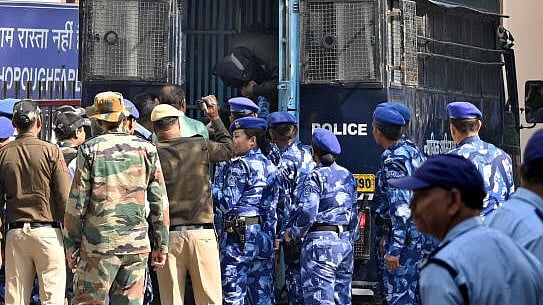
Amir Rashid Ali, a resident of Pampore in Indian Kashmir, is escorted by police after he was arrested by NIA, in New Delhi
Credit: PTI Photo
Srinagar: The National Investigation Agency (NIA) on Tuesday arrested another key suspect in the Red Fort car bomb blast case, intensifying its probe into what officials describe as a sophisticated “white-collar terror module” involving radicalised youth and educated professionals from Kashmir.
The agency said it had arrested Jasir Bilal Wani, alias Danish, a resident of Qazigund in Anantnag district, from Srinagar. Jasir is the son of Bilal Ahmad Wani, a dry fruit seller who set himself on fire on Sunday, allegedly after being repeatedly denied permission to meet his detained son and brother. Bilal, shifted from Anantnag Hospital to SMHS Hospital late Sunday night, died of severe burn injuries shortly after midnight.
Jasir’s arrest marks a significant addition to the agency’s list of alleged conspirators in the Red Fort blast investigation (RC-21/2025/NIA/DLI). According to the NIA, he played a critical technical role, allegedly modifying drones and attempting to fabricate rudimentary rockets ahead of the November 10 car bombing in Delhi that killed 13 people and injured more than 30. Investigators say he worked closely with the suspected suicide bomber Umar un Nabi, a Kashmiri doctor who died in the explosion.
The arrest comes amid growing scrutiny of a terror ecosystem that officials say involved doctors, university students and other white-collar professionals who were recruited and indoctrinated by handlers based within and outside India.
The network first drew attention after NIA arrested several Kashmiri doctors studying at Al-Falah University in Faridabad, early this month. Those arrests stunned security circles, which described the cell as one deeply embedded in urban institutions, technologically adept and able to operate under the cover of respectable social roles.
In mid-October, police in Srinagar had also recovered posters of a Jaish-e-Mohammad–linked outfit in Nowgam, weeks before the Red Fort attack. Officials now believe the posters were not random but part of a calibrated campaign to signal the reorganisation of a hybrid module blending local radicalisation with foreign technical guidance.
The latest breakthrough also comes days after a separate blast inside Nowgam Police Station on November 14, where seized explosives detonated during forensic handling, killing nine policemen and injuring around 30.
While investigators have not established a direct connection between the Nowgam incident and the Red Fort bombing, they are examining whether common suppliers, handlers or technical trainers may link the two episodes.
The NIA said it is “exploring all angles” to unravel the conspiracy behind the Red Fort bombing. Teams from the agency are pursuing leads across Delhi, Jammu & Kashmir, Haryana and Uttar Pradesh, conducting searches to identify every individual linked to planning, execution or facilitation.
According to investigators, Jasir Wani was an active co-conspirator, assisting Umar un Nabi in preparing explosive devices, studying drone flight patterns and conducting modification trials — technical support that officials say was central to the operational planning of the attack.
The arrest strengthens the agency’s assessment that the network is not a fringe group but a highly organised module with logistical chains, drone engineers, radicalised medical students and technology-trained operatives — a structure more complex than earlier Kashmir-based terror formations.
Officials said more arrests are expected as the agency maps the recruitment network and identifies radicalisers, financiers and ideological mentors believed to be working through encrypted channels and educational campuses.
The probe, the NIA said, aims to expose “every node of the network”, particularly those responsible for drawing educated youth into extremism — a trend investigators describe as one of the most disturbing developments in Kashmir’s recent security landscape.